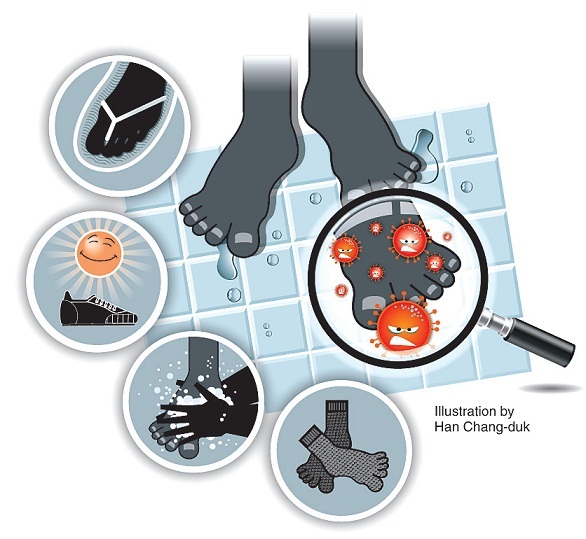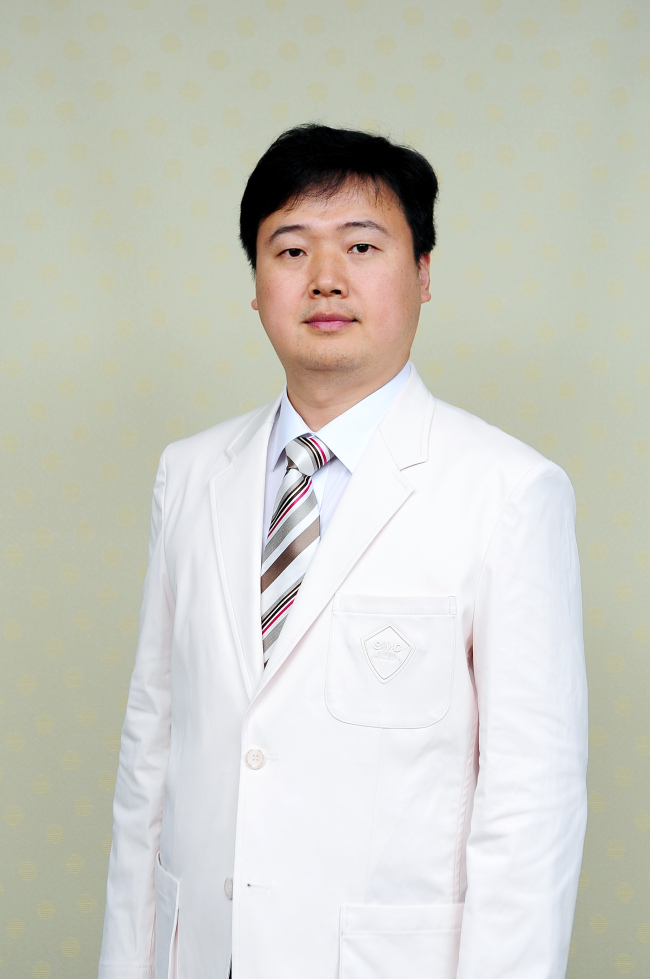What is athlete’s foot?
Athlete’s foot is an infectious disease caused by a type of fungus (dermatomyces) that infects the skin between the toes, the lower surface of the foot and the hands. Dermatomyces reproduces actively in a warm, moist environment, so athlete’s foot is common during summer, particularly during the rainy season.
Types and symptoms
There are three types of athlete’s foot, which differ according to the location of the infection and the symptoms ― hyperkeratotic, interdigital and vesicular.
1. Hyperkeratotic ― This type is associated with silvery scales (raised dead skin cells) and dry skin, which leads to skin cracking. It leads to a thickened dead skin layer on the foot, producing fine white powder if scratched. This is the most common type of athlete’s foot.
2. Interdigital ― This is associated with severe itchiness, and white and ulcerated skin. If the skin becomes dry, it can form scales and can smell bad.
3. Vesicular ― This is a less common form that is associated with sporadic small vesicles, which can combine to produce various sizes and shapes. It is associated with severe itching when the vesicles form, and when they rupture it can become eczematous with ooze and scabs.
Pathogens that have adapted to persons do not cause severe symptoms. However, pathogens that infect animals or are found in soil can cause more severe diseases.
Dermytomyces not only infects the foot, as is commonly thought, but can infect any area of skin depending on environmental and lifestyle factors, occupation, immune status and the type of pathogen. Infection of the groin or the scrotum is called eczema marginatum, infection of skin under the fingernails or toenails is called tinea unguium, infection in the head is called tinea capitis of the scalp and infection of the trunk is called tinea corporis.
Diagnosis
Dermatomyces infection, particularly infection of the foot, can present problems similar to those of skin conditions such as eczema, psoriasis and hyperkeratosis. Therefore, self-treatment based on the symptoms alone is not advised. It is important to see a doctor for an accurate diagnosis. If you have tried using over-the-counter ointment for one week or so and have not seen an improvement, you should see a doctor for treatment.
Treatment
If the skin is not ulcerated, clean the skin well so that the layer of dead skin cells is softer. Then apply antifungal ointment or cream and leave your skin to dry. Wear cotton socks and shoes or sandals that allow good airflow. People who find no improvement in athlete’s foot generally have not received appropriate care, or have not taken measures to prevent recurrence. Therefore, it is important to continue to use antifungal creams for two weeks even after the remission of symptoms. If you do not see an improvement, visit the hospital for oral antifungal medication or another appropriate treatment.
Mode of infection
Athlete’s foot can be caused by direct contact, but it is usually transferred from skin tissue from a carrier in public areas such as pools or public baths. Infected domestic cats or dogs can also transfer the infection to people. Pathogens in soil can also lead to infection so personal hygiene is important.
Prevention
1. Washing your feet: For feet hygiene you need to remove salt in the dead skin layer sufficiently. Salt in skin leads to absorption of moisture by osmosis from the atmosphere, leading to moist skin. To remove salt, wash your feet by soaking them in cold water for at least 10 minutes. Feet-washing is important, but it is also very important to keep your feet dry afterwards. It helps to use a blow-dryer or a fan to dry your feet, or you can use nonirritating athlete’s foot prevention powder to remove moisture from your feet.
2. Disinfecting shoes: Athlete’s foot is contagious so you should keep your socks and shoes separate. If possible, rotate between at least three pairs of shoes. Stay barefooted as often as possible, and wear shoes such as slippers to allow air in. Dry your shoes in sunlight after coming home to kill the germs, or put cotton with formalin inside the shoes and wrap in a plastic bag. You can also use antifungal products for car air conditioners.
3. Wearing toe socks
Cotton toe socks that absorb sweat are helpful against erosion between the toes. However, socks with synthetic soles for athlete’s foot have not been proven to be effective.
Complications
Secondary bacterial infection can occur on top of athlete’s foot. Be careful of ruptured vesicles as this can lead to infection. If this happens, the secondary bacterial infection is treated before treating athlete’s foot. Using antifungal cream for athlete’s foot alone can lead to worsening of symptoms. The treatment of athlete’s foot is different if there is secondary bacterial infection or it has become eczematous, so make sure you see a doctor for appropriate treatment.
 |
| Lee Dong-youn |
By Lee Dong-youn
The author is a dermatologist at Samsung Medical Center and a professor at Sungkyunkwan University’s School of Medicine. ― Ed.

